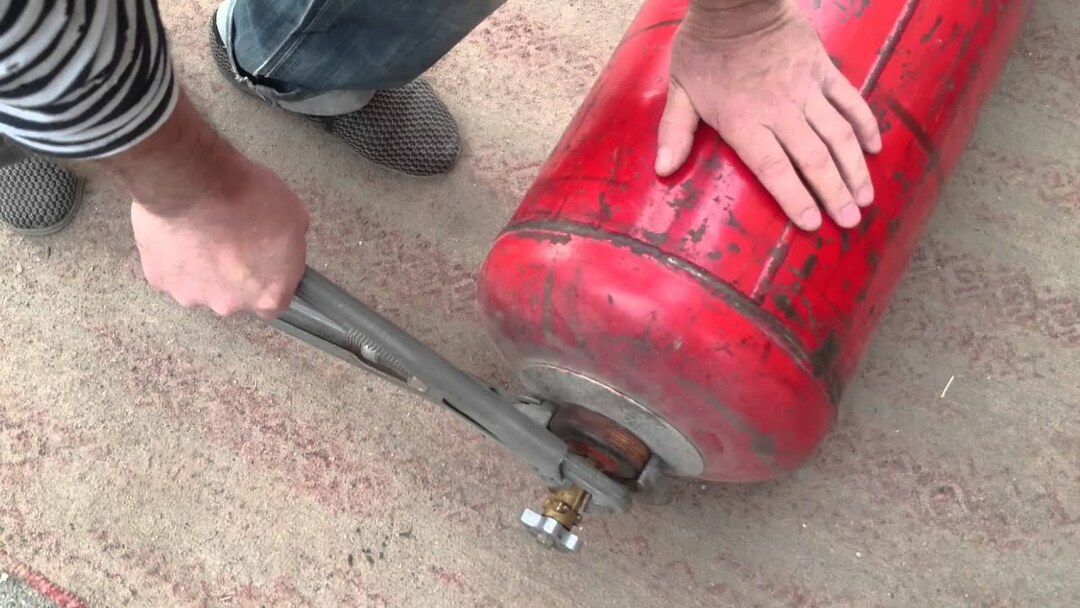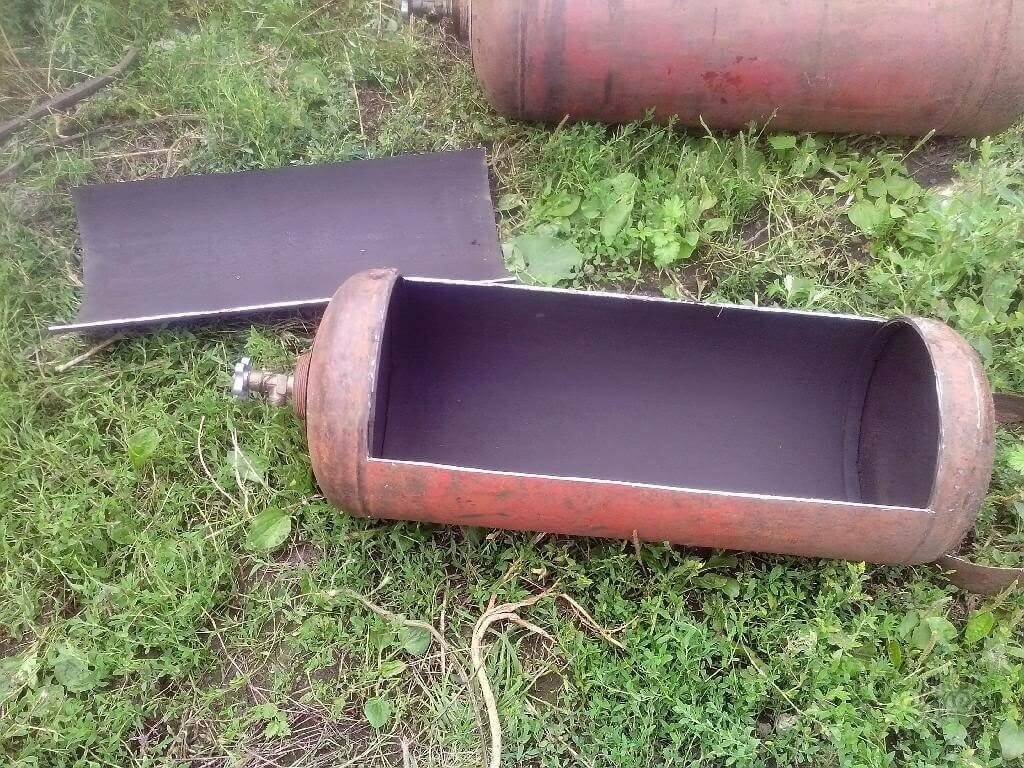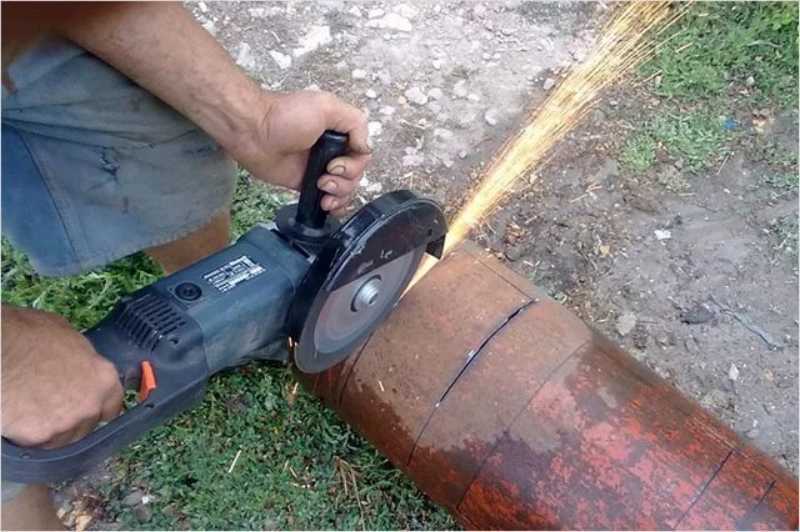Surely, you have often wondered what can be done from an old gas cylinder? An amateur will take the receiver for unnecessary scrap metal and send it to a landfill, but only a real master will be able to use the container as the basis for a new product.
Agree, a used gas cylinder is an ideal case for a homemade barbecue, smokehouse, boiler or even fireplace. Detailed instructions will help even a beginner quickly understand how to disassemble a gas cylinder as safely as possible.
Disassembling the receiver requires the master to comply with important rules applied to safely cut a container in which flammable materials were stored. We have compiled detailed instructions for disassembling a propane cylinder, which describes step by step how to free the container from gas residues and cut correctly.
The content of the article:
- Using a cut-through gas receiver
-
Step-by-step instructions for disassembling a gas cylinder
- A set of tools for work
- Removing the cylinder valve
- Gas cylinder flushing
- Gas receiver cutting
- Safety rules when working with a grinder
- What you should pay attention to?
- Conclusions and useful video on the topic
Using a cut-through gas receiver
Due to the massive connection of all houses to the gasification system, gas receivers have lost their popularity. That is why today many craftsmen have set themselves the goal of making new designs from used cylinders that perform completely different functions.
The first thing that comes to mind when looking for options for using a gas receiver is homemade stove. In this case, a propane cylinder is an ideal case for a furnace, since its walls are 3 mm thick, which is just enough for safe operation.

The design does not require complex modifications, so that, with all the necessary components, it can be assembled in just one day
Especially popular barbecue grill from a gas cylinder. To make such a mobile grill, you will need a simple cylinder, an old gas stove burner, a grill grate and a tray.
The inner lining of the body allows you to safely cook food in the brazier, even with the lid closed. A gas grill from a used receiver is ideal for a spacious summer cottage where you can gather a large group of friends.

When constructing such a complex structure, you can use not only a gas receiver, but also a barrel made of food stainless steel
Several cylinders can be used to build a real smokehouse with separate containers for hot and cold smoking, barbecue and grill compartment. The design can be adapted both for skewers and under the wire rack, which allows you to cook meat and fish in different ways. When making such a complex structure, you should understand the principle of the smokehouse, therefore it is recommended to rely on the drawing.
The process of disassembling an old gas cylinder requires special care on the part of the master, since even a slight residue of gas inside the container when interacting with a spark from a grinder can provoke explosion. The process of sawing the gas receiver is preceded by a preparatory stage, which includes releasing the gas and filling the cylinder with water.
Step-by-step instructions for disassembling a gas cylinder
If all the necessary tools are prepared, then you can safely get to work. In this case, it is important to perform all the actions in the presented sequence in order to avoid mistakes in the process of disassembling the gas receiver.
A set of tools for work
Disassembly of carbon dioxide or oxygen cylinders is carried out without preliminary preparation, because after bleeding gas, these are ordinary metal cylinders that can be safely cut grinder. With propane cylinders, things are a little different, so the container will have to be prepared before sawing work.
To do this, you need the following tools:
- gas wrench to open valveto release all gas from the cylinder;
- manual hacksaw for metal for cutting off the neck of the cylinder;
- funnel and watering hose for filling the receiver with water;
- grinder with cutting discs of different thickness.
When working with a grinder, you should be especially careful, because in this case the master will have to work with an uneven surface, which can cause the tool to slide off during the metal cutting process.
If you have not previously worked with a grinder, then it is better to start practicing on a flat sheet of metal.

It is recommended to protect your body as much as possible when working with a grinder, because if it comes into contact with the skin, the fragments can form burns
Before starting work, it is recommended to put on a protective cover and goggles, which will serve as reliable protection against fragments and combustible abrasives. An important condition is to choose the right wheel for a specific thickness of the material, because often the discrepancy between the abrasive wheel and the metal can lead to its rapid grinding.
Before you start disassembling a 50 liter gas cylinder, you must open the valve with a gas wrench to completely bleed the gas. The presence of even a small volume of gas inside the container can lead to fire or explosion, therefore, no matter how old the cylinder is, it must be emptied of propane residues.
Coating the valve with a soapy liquid will help ensure that there is no more gas left in the receiver. You can get rid of the gasoline residues only after the valve is completely removed.
Removing the cylinder valve
Further, it is recommended to unscrew the valve with the subsequent removal of the pins and the fixing element. This is a rather laborious process, since the locking mechanism of the valve is difficult to unwind.

To reduce the likelihood of fire to a minimum, it is better to unscrew the valve yourself, without resorting to cutting it off with a hacksaw
Upon successful completion of the process, a hole with a diameter of 6 mm is formed at the place of the valve. If you can't open the valve in any way, then it can be cut off using an ordinary hacksaw for metal.
Gas cylinder flushing
After removing the valve, the gas cylinder is completely filled with water. This is necessary to completely remove any gas that may have remained inside the container. The resulting solution from water and gas residues is safe, so it can be safely drained without fear of subsequent fire. However, it is recommended to do this away from structures, since the liquid has a rather pungent odor.
So, by bleeding off the gas and rinsing the cylinder with clean water, all the propane residues were removed from the container. Then you can safely proceed directly to cutting the receiver.
Depending on the features of the future design, markings are made on the surface of the cylinder using chalk. In some cases, cutting is carried out along welded seams, which, in turn, are notable for their low strength.
Gas receiver cutting
Before you start cutting the cylinder, it is worth considering the thickness of the metal used. On average, the thickness of the steel of the propane receiver is 3-4 mm, while at the joints the indicators can reach 5-6 mm. Almost any grinder is suitable for such purposes, however, special attention should be paid to the choice of an abrasive wheel.
In order not to encounter additional difficulties in the process of cutting the receiver, you can first walk the grinder along the markings, using a 1.6 mm thick disc. The next time you cut metal, you will need to use a wider blade to avoid the bit getting stuck during the final cut.

If even after rinsing the cylinder with water, a pungent smell of gas remains inside, then it is better to burn the inner surface of the container with a blowtorch
Thicker elements, such as joints, can be cut with a grinder and then split with a hammer. Acceleration of the process of disassembling a gas cylinder has a detrimental effect on the quality of the final result, therefore it is better to do everything consistently, and not resort to using a chisel or hammer to cut joints.
Regardless of the purpose of the gas receiver, the preparation of the case is carried out according to the instructions provided. From an ordinary propane cylinder, you can make both a stove-stove and a mobile brazier.
It should be understood that to use the receiver body as a barbecue or smokehouse, an external the surface of the structure will need to be coated with non-stick paint, and the inner one will need to be burned with blowtorch.
Safety rules when working with a grinder
In the process of cutting metal, it is important to take into account the basic rules for the operation of the grinder, which allow the master to create the safest conditions for the duration of work.
The features of working with a grinder include the following rules:
- Before starting work with the grinder, you must wear a special protective suit made of non-combustible material. It is not recommended to cut metal in clothes with exposed skin, as if fragments hit its surface, a burn may form.
- Before you start cutting metal, you should pay special attention to the condition of the disc. It is recommended to inspect the nozzle for defects, assess the degree of its wear.
- Metal cutting is carried out only in goggles, since in the process of work, a huge number of fragments are formed, which fly in different directions, and can cause serious eye injury.
In some cases, the steel cutting procedure is divided into several stages. This is necessary when the nozzle heats up during a long cut, because of which it wears out quickly.
In addition, long-term operation of the grinder often leads to malfunctions in its work, which can even lead to injury to the master.

In the process of metal processing, it is recommended to stand on the side of the cutting line so that the maximum part of the fragments does not fly towards the master
Professional craftsmen recommend using a respirator when working with a grinder, because when when cutting steel, microscopic fragments of metal can be thrown into the air, which are deposited in the respiratory tract person.
What you should pay attention to?
Disassembling even an old gas cylinder requires special care from the master, and the sequence of all actions.
For novice craftsmen who have not yet had to deal with sawing a propane receiver, we have prepared some useful tips:
- the degree of harshness of the propane odor when rinsing the cylinder is an indicator of a high probability of fire or explosion;
- it is better to unscrew the cylinder valve away from living quarters;
- cutting a propane cylinder near a fire or any other source of fire is contraindicated;
- it is forbidden to stand in front of the gas outlet from the receiver, especially if there is a characteristic hiss;
- the markings on the cylinder should be indicated in advance, so as not to make a mistake with the calculations.
If there is a pronounced smell of propane, it is better to rinse the receiver again, and only then proceed to sawing off the valve.
If the smell is still harsh, then it is better to postpone the work for a few days and wait until it has completely disappeared.

Such a device will help to quickly and effectively clean the gas cylinder from rust, and prepare the surface for further painting.
Immediately after cutting, the container must be cleaned of old paint, and then carefully cleaned with sandpaper to create the most even surface.
The easiest way is to install a grinding flap wheel on the grinder, which will facilitate the further surface treatment process, including painting.
Conclusions and useful video on the topic
The article presented step-by-step instructions for parsing a gas cylinder, including the secrets of proper gas release and rinsing the cylinder with clean water. A few simple rules for working with a grinder will help to correctly cut the container capacity, reducing the likelihood of a fire or explosion to a minimum.
A prerequisite is the preservation of the sequence of actions presented in the instructions, since the successful completion of work on the disassembly of the gas receiver depends on this.
You can learn how to avoid an explosion of a gas cylinder in the process of parsing it from the video:
You can unscrew the valve of the propane receiver, without the need to cut it down, in the following way:
Have you ever had to disassemble a gas cylinder yourself? Share your experience with our readers, tell us about the problems that you had to face when disassembling a propane receiver. Tell your story in the comments below the article, where you can also ask our experts your questions.


